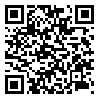Volume 13, Issue 1 (3-2023)
J Adv Biomed Sci. 2023, 13(1): 68-80 |
Back to browse issues page
Majid Naderi1 

 , Sahar Najafi2
, Sahar Najafi2 

 , Mohammad Hossein Ahmadi3
, Mohammad Hossein Ahmadi3 

 , Fariba Ramezani Siakhulak4
, Fariba Ramezani Siakhulak4 

 , Saeedeh Yaghoubi5
, Saeedeh Yaghoubi5 

 , Younes Sadeghi-Bojd *6
, Younes Sadeghi-Bojd *6 




 , Sahar Najafi2
, Sahar Najafi2 

 , Mohammad Hossein Ahmadi3
, Mohammad Hossein Ahmadi3 

 , Fariba Ramezani Siakhulak4
, Fariba Ramezani Siakhulak4 

 , Saeedeh Yaghoubi5
, Saeedeh Yaghoubi5 

 , Younes Sadeghi-Bojd *6
, Younes Sadeghi-Bojd *6 


1- Non-Communicable Disease Research Center, Zahedan University of Medical Sciences, Zahedan, Iran
2- Department of Clinical Laboratory Sciences, School of Paramedical Sciences, Ahvaz Jundishapur University of Medical Sciences, Ahvaz, Iran
3- Department of Laboratory Sciences, School of Paramedical and Rehabilitation Sciences, Mashhad University of Medical Sciences, Mashhad, Iran
4- Department of Epidemiology, Health Promotion Research Center, Zahedan University of Medical Sciences, Zahedan, Iran
5- Department of Pediatrics, Children and Adolescents Health Research Center, Research Institute of cellular and Molecular Science in Infectious Diseases, Zahedan University of Medical Sciences, Zahedan, Iran
6- Department of Laboratory Sciences, School of Allied Medical Sciences, Zahedan University of Medical Sciences, Zahedan, Iran ,Younessadeghibojd@gmail.com
2- Department of Clinical Laboratory Sciences, School of Paramedical Sciences, Ahvaz Jundishapur University of Medical Sciences, Ahvaz, Iran
3- Department of Laboratory Sciences, School of Paramedical and Rehabilitation Sciences, Mashhad University of Medical Sciences, Mashhad, Iran
4- Department of Epidemiology, Health Promotion Research Center, Zahedan University of Medical Sciences, Zahedan, Iran
5- Department of Pediatrics, Children and Adolescents Health Research Center, Research Institute of cellular and Molecular Science in Infectious Diseases, Zahedan University of Medical Sciences, Zahedan, Iran
6- Department of Laboratory Sciences, School of Allied Medical Sciences, Zahedan University of Medical Sciences, Zahedan, Iran ,
Abstract: (1587 Views)
Background & Objectives: Beta-thalassemia is one of the complex diseases that causes many social and economic problems for the patient and his family. This study aimed to investigate factors influencing the birth of thalassemia (intermedia or major) in family members with thalassemia major in Sistan and Baluchistan province.
Materials & Methods: This descriptive-analytical study was conducted by census sampling on 48 families of thalassemia major patients with at least two children with thalassemia (intermedia or major) in their members. Data were collected through direct interviews and a review of patients' documents. The results were analyzed by SPSS (version 22) and Mann-Whitney U, Independent t-test, Wilcoxon, and Chi-square tests.
Results: In this study, statistical evaluations showed that the birth of thalassemia in family members with thalassemia major whose mothers are housewives was 100% and in families that had no premarital counseling was 91.7%. There was a significant relationship between variables related to mothers' awareness of thalassemia, including their place of residence and Sistani and Baluchestani ethnics, and the birth of thalassemia in family members with thalassemia major (in both cases, P-value = 0.05); However, there was no significant relationship between other variables related to mothers' awareness such as age groups and maternal education with the birth of thalassemia in family members with thalassemia major (P-Value = 0.98 and P-Value = 0.22, respectively).
Conclusion: Informing and educating before marriage for high-risk families with thalassemia children, as well as financial support for low-income families can inform parents, prevent the birth of thalassemia, and improve the quality of life of these patients.
Type of Study: Research |
Subject:
Hematology
Received: 2023/01/3 | Accepted: 2023/02/20 | Published: 2023/04/24
Received: 2023/01/3 | Accepted: 2023/02/20 | Published: 2023/04/24
| Rights and permissions | |
 |
This work is licensed under a Creative Commons Attribution-NonCommercial 4.0 International License. |


